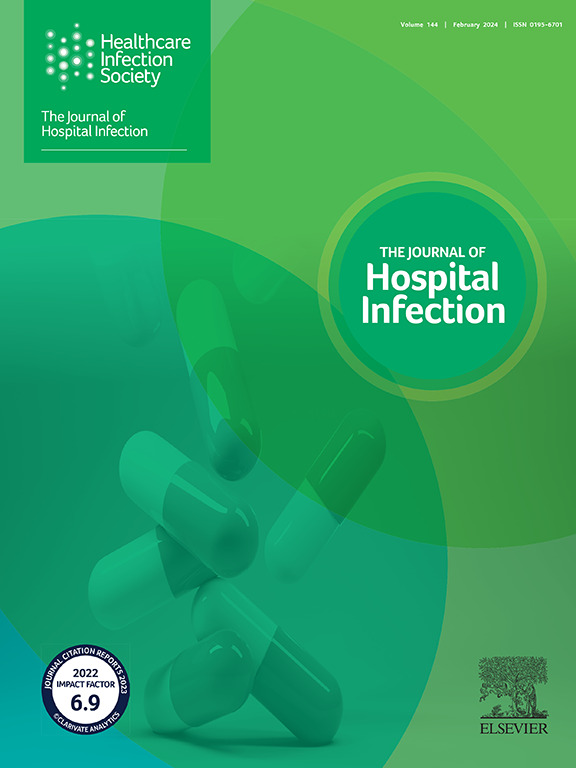Surgical site infection prevention care bundles in colorectal surgery: a scoping review
IF 3.9
3区 医学
Q1 INFECTIOUS DISEASES
引用次数: 0
Abstract
Background
Surgical site infection (SSI) prevention bundles have been used to reduce infection rates in most types of surgery. Bundles tailored to colorectal surgery have been used with success.
Aim
To identify and review the individual interventions that constitute each SSI prevention care bundle in colorectal surgery, and the reduction in SSI rate associated with their implementation.
Methods
A scoping review was conducted in PubMed, CINAHL, Web of Science Core Collection and Scopus in December 2022.
Results
This review analysed 48 of 164 identified studies on SSI prevention in colorectal surgery from 2011 to 2022. It revealed an average of 11 interventions per study, primarily in the pre-operative [mechanical bowel preparation, oral antibiotic bowel decontamination, hair removal, chlorhexidine gluconate (CHG) shower, normoglycaemia], intra-operative (antibiotic prophylaxis, normothermia, CHG skin preparation, antibiotic prophylaxis re-dosing, gown/glove change) and postoperative (normothermia, normoglycaemia, dressing removal, oxygen optimization, incision cleansing) periods. Despite these interventions, SSI rates remain high, indicating a need for further research to optimize intervention bundles and improve compliance across surgical stages.
Conclusions
The implementation of SSI prevention bundles, tailored to colorectal surgery, has shown a reduction in SSI rates and costs. Grouping interventions according to the peri-operative phase may increase compliance.
结直肠手术中的手术部位感染预防护理捆绑:范围界定综述。
背景:手术部位感染预防包已被用于降低大多数类型手术的感染率。目的:确定并回顾构成结直肠手术感染预防护理包的各项干预措施,以及与实施这些措施相关的手术部位感染率降低情况:方法:2022 年 12 月,在 PUBMED、CINAHL、Web of Science Core Collection 和 Scopus 数据库中进行了范围界定综述:本综述分析了 2011 年至 2022 年间 164 项已确定的结直肠手术中手术部位感染 (SSI) 预防研究中的 48 项。结果显示,每项研究平均采取了 11 项干预措施,主要涉及术前(机械肠道准备、口服抗生素肠道净化、脱毛、CHG 淋浴、正常血糖)、术中(抗生素预防、正常体温、CHG 皮肤准备、抗生素预防再用药、更换手术衣/手套)和术后阶段(正常体温、正常血糖、去除敷料、氧气优化、切口清洁)。尽管采取了这些干预措施,但 SSI 感染率仍然很高,这表明有必要进一步开展研究,优化干预措施捆绑,提高各手术阶段的依从性:结论:针对结直肠手术实施的手术部位感染预防捆绑措施已显示出手术部位感染率和成本的降低。根据围手术期进行分组干预可能有助于提高依从率。
本文章由计算机程序翻译,如有差异,请以英文原文为准。
求助全文
约1分钟内获得全文
求助全文
来源期刊

Journal of Hospital Infection
医学-传染病学
CiteScore
12.70
自引率
5.80%
发文量
271
审稿时长
19 days
期刊介绍:
The Journal of Hospital Infection is the editorially independent scientific publication of the Healthcare Infection Society. The aim of the Journal is to publish high quality research and information relating to infection prevention and control that is relevant to an international audience.
The Journal welcomes submissions that relate to all aspects of infection prevention and control in healthcare settings. This includes submissions that:
provide new insight into the epidemiology, surveillance, or prevention and control of healthcare-associated infections and antimicrobial resistance in healthcare settings;
provide new insight into cleaning, disinfection and decontamination;
provide new insight into the design of healthcare premises;
describe novel aspects of outbreaks of infection;
throw light on techniques for effective antimicrobial stewardship;
describe novel techniques (laboratory-based or point of care) for the detection of infection or antimicrobial resistance in the healthcare setting, particularly if these can be used to facilitate infection prevention and control;
improve understanding of the motivations of safe healthcare behaviour, or describe techniques for achieving behavioural and cultural change;
improve understanding of the use of IT systems in infection surveillance and prevention and control.
 求助内容:
求助内容: 应助结果提醒方式:
应助结果提醒方式:


